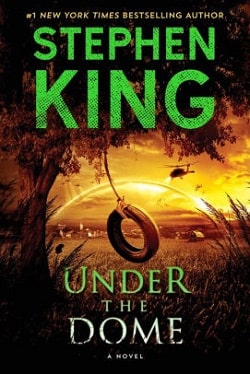Under the Dome by Stephen King is a sprawling, ambitious novel that encapsulates the essence of human nature when faced with extraordinary circumstances. Set in the small town of Chester’s Mill, Maine, the story begins with an inexplicable event: an invisible force field, dubbed "the Dome," suddenly encloses the town, cutting it off from the outside world. This premise serves as a powerful metaphor for isolation, both physical and psychological, and King masterfully explores the ensuing chaos that unfolds within this microcosm of society.
One of the most striking aspects of Under the Dome is its exploration of **power dynamics** and **human behavior** under duress. The narrative introduces a diverse cast of characters, each representing different facets of society. At the forefront is Dale Barbara, an Iraq War veteran turned short-order cook, who embodies the moral compass of the story. His character is a study in resilience and leadership, as he rallies a group of townspeople to confront the escalating crisis. Alongside him is Julia Shumway, the town’s newspaper owner, who serves as a voice of reason and a catalyst for change. Together, they symbolize hope and the fight for justice in a world rapidly descending into chaos.
In stark contrast to Barbara and Shumway is Big Jim Rennie, a corrupt politician who seeks to exploit the situation for his own gain. Rennie’s character is a chilling representation of **authoritarianism** and the lengths to which individuals will go to maintain power. His willingness to resort to **manipulation, deceit, and even murder** highlights the darker aspects of human nature, making him a formidable antagonist. The tension between Barbara and Rennie serves as a central conflict in the novel, illustrating the struggle between good and evil that is a recurring theme in King’s work.
The Dome itself acts as a character in its own right, representing both a physical barrier and a psychological one. As the story progresses, the Dome becomes a catalyst for revealing the true nature of the townspeople. The isolation exacerbates existing tensions, leading to **paranoia, fear, and ultimately violence**. King deftly examines how societal norms can quickly erode when faced with desperation, as characters are forced to confront their own moral boundaries. This theme resonates deeply, reflecting contemporary societal issues where fear can lead to division and conflict.
King’s ability to create a sense of place is unparalleled, and Chester’s Mill is vividly brought to life. The town, with its familiar small-town charm, becomes a claustrophobic prison, amplifying the sense of dread and urgency. The detailed descriptions of the town’s layout and the characters’ interactions within it enhance the reader’s immersion in the story. As the Dome’s presence looms, the once idyllic setting transforms into a battleground, where survival instincts take precedence over civility.
Character development is another hallmark of King’s storytelling, and Under the Dome is no exception. Each character is intricately crafted, with their backstories and motivations explored in depth. The supporting cast, including the children who play pivotal roles in the narrative, adds layers to the story. Their innocence juxtaposed with the adults’ moral failings serves to highlight the impact of the Dome on future generations. King’s exploration of **childhood innocence** amidst chaos is poignant, reminding readers of the fragility of hope in dire circumstances.
The pacing of the novel is relentless, with tension building steadily as the story unfolds. King expertly balances moments of introspection with high-stakes action, ensuring that readers remain engaged throughout. The narrative is interspersed with moments of dark humor, a signature element of King’s writing, which provides brief respites from the tension while also underscoring the absurdity of the situation. This blend of humor and horror is a testament to King’s skill as a storyteller, allowing readers to navigate the emotional landscape of the novel with ease.
While Under the Dome is a work of fiction, its themes resonate with real-world issues, making it a thought-provoking read. The novel raises questions about **leadership, morality, and the human condition** when stripped of societal norms. It invites readers to reflect on how they might respond in similar situations, challenging them to consider the implications of isolation and fear on their own lives. The story serves as a cautionary tale about the fragility of civilization and the potential for darkness that lies within us all.
In comparison to other dystopian works, such as *The Stand* or *Lord of the Flies*, King’s narrative stands out for its intricate character development and exploration of societal breakdown. While both novels delve into the collapse of civilization, Under the Dome focuses on the microcosm of a single town, allowing for a more intimate examination of human behavior. This approach creates a sense of urgency and immediacy, drawing readers into the emotional turmoil of the characters as they grapple with their new reality.
In conclusion, Under the Dome is a masterful exploration of human nature, power, and the consequences of isolation. Stephen King’s ability to weave complex characters and themes into a gripping narrative makes this novel a compelling read. It challenges readers to confront their own beliefs about morality and leadership in times of crisis, leaving a lasting impact long after the final page is turned. For those who appreciate a blend of psychological depth and thrilling suspense, Under the Dome is a must-read that will resonate with audiences for years to come.
























Reviews 0
Post a Reviews: